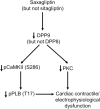Saxagliptin but Not Sitagliptin Inhibits CaMKII and PKC via DPP9 Inhibition in Cardiomyocytes
- PMID: 30487758
- PMCID: PMC6246635
- DOI: 10.3389/fphys.2018.01622
Saxagliptin but Not Sitagliptin Inhibits CaMKII and PKC via DPP9 Inhibition in Cardiomyocytes
Abstract
Some oral anti-hyperglycemic drugs, including gliptins that inhibit dipeptidyl peptidase 4 (DPP4), have been linked to the increased risk of heart failure (HF) in type-2 diabetic patients. While the cardiovascular safety trial, TECOS, revealed no link between sitagliptin and the risk of HF, a substantial 27% increase in the hospitalization for HF was observed in type-2 diabetic patients treated with saxagliptin within the SAVOR-TIMI 53 trial. A previous in vitro study revealed that saxagliptin impairs the Ca2+/calmodulin-dependent protein kinase II (CaMKII)-phospholamban (PLB)-sarcoplasmic reticulum Ca2+-ATPase 2a axis and protein kinase C (PKC) activity in cardiomyocytes leading to impaired cardiac contractility and electrophysiological function. However, the link between saxagliptin and its target proteins (CaMKII and PKC) remains to be explored. Since DPP8 and DPP9 (but not DPP4) are expressed by cardiomyocytes and saxagliptin is internalized by cardiomyocytes, we investigated whether DPP8/9 contribute to saxagliptin-mediated inhibition of CaMKII and PKC activity. Structural analysis revealed that the DPP4-saxagliptin interaction motif (S630, Y547) for the cyanopyrrolidine group is conserved in DPP8 (S755, Y669) and DPP9 (S730, Y644). Conversely, F357 that facilitates binding of the anchor lock domain of sitagliptin in the S2 extensive subsite of DPP4 is not conserved in DPP8/9. In parallel, unlike saxagliptin, sitagliptin did not affect phosphorylation of CaMKII/PLB or activity of PKC in HL-1 cardiomyocytes. These findings were recapitulated by pharmacological inhibition (TC-E-5007, a DPP8/9 antagonist) and knock-down of DPP9 (but not DPP8). In primary mouse ventricular cardiomyocytes, saxagliptin (but not sitagliptin) impaired Ca2+ transient relaxation and prolonged action potential duration (APD). These results suggest that saxagliptin-DPP9 interaction impairs the CaMKII-PLB and PKC signaling in cardiomyocytes. We reveal a novel and potential role of DPP9 in cardiac signaling. The interaction of saxagliptin with DPP9 may represent an underlying mechanism for the link between saxagliptin and HF. Elucidation of saxagliptin-DPP9 interaction and downstream events may foster a better understanding of the role of gliptins as modulators of cardiac signaling.
Keywords: Ca2+ transient; cardiac electrophysiology; diabetes; gliptins; heart failure.
Figures







Similar articles
-
Dipeptidyl peptidase-4 independent cardiac dysfunction links saxagliptin to heart failure.Biochem Pharmacol. 2017 Dec 1;145:64-80. doi: 10.1016/j.bcp.2017.08.021. Epub 2017 Aug 30. Biochem Pharmacol. 2017. PMID: 28859968
-
Establishment of a selective evaluation method for DPP4 inhibitors based on recombinant human DPP8 and DPP9 proteins.Acta Pharm Sin B. 2014 Apr;4(2):135-40. doi: 10.1016/j.apsb.2013.12.007. Epub 2014 Jan 17. Acta Pharm Sin B. 2014. PMID: 26579375 Free PMC article.
-
DPP8 and DPP9 expression in cynomolgus monkey and Sprague Dawley rat tissues.Regul Pept. 2013 Sep 10;186:26-35. doi: 10.1016/j.regpep.2013.07.003. Epub 2013 Jul 12. Regul Pept. 2013. PMID: 23850796
-
Unravelling the immunological roles of dipeptidyl peptidase 4 (DPP4) activity and/or structure homologue (DASH) proteins.Clin Exp Immunol. 2016 Jun;184(3):265-83. doi: 10.1111/cei.12757. Epub 2016 Mar 2. Clin Exp Immunol. 2016. PMID: 26671446 Free PMC article. Review.
-
Dipeptidyl Peptidase 4 Inhibitors and the Risk of Cardiovascular Disease in Patients with Type 2 Diabetes: A Tale of Three Studies.Diabetes Metab J. 2015 Oct;39(5):373-83. doi: 10.4093/dmj.2015.39.5.373. Epub 2015 Oct 22. Diabetes Metab J. 2015. PMID: 26566494 Free PMC article. Review.
Cited by
-
Dipeptidyl peptidase 4 inhibitors in the treatment of type 2 diabetes mellitus.Nat Rev Endocrinol. 2020 Nov;16(11):642-653. doi: 10.1038/s41574-020-0399-8. Epub 2020 Sep 14. Nat Rev Endocrinol. 2020. PMID: 32929230 Review.
-
New insights into the role of dipeptidyl peptidase 8 and dipeptidyl peptidase 9 and their inhibitors.Front Pharmacol. 2022 Sep 12;13:1002871. doi: 10.3389/fphar.2022.1002871. eCollection 2022. Front Pharmacol. 2022. PMID: 36172198 Free PMC article. Review.
-
Relationship between key continuous glucose monitoring-derived metrics and specific cognitive domains in patients with type 2 diabetes mellitus.BMC Neurol. 2023 May 20;23(1):200. doi: 10.1186/s12883-023-03242-2. BMC Neurol. 2023. PMID: 37210479 Free PMC article.
-
Physiology and Pharmacology of DPP-4 in Glucose Homeostasis and the Treatment of Type 2 Diabetes.Front Endocrinol (Lausanne). 2019 Feb 15;10:80. doi: 10.3389/fendo.2019.00080. eCollection 2019. Front Endocrinol (Lausanne). 2019. PMID: 30828317 Free PMC article. Review.
-
New Insights into the Pleiotropic Actions of Dipeptidyl Peptidase-4 Inhibitors Beyond Glycaemic Control.touchREV Endocrinol. 2024 Oct;20(2):19-29. doi: 10.17925/EE.2024.20.2.5. Epub 2024 Sep 6. touchREV Endocrinol. 2024. PMID: 39526061 Free PMC article. Review.
References
-
- Berger J. P., Sinharoy R., Pocai A., Kelly T. M., Scapin G., Gao Y. D., et al. (2018). A comparative study of the binding properties, dipeptidyl peptidase-4 (DPP-4) inhibitory activity and glucose-lowering efficacy of the DPP-4 inhibitors alogliptin, linagliptin, saxagliptin, sitagliptin and vildagliptin in mice. Endocrinol. Diabetes Metab. 1:e00002 10.1002/edm2.2 - DOI - PMC - PubMed
Grants and funding
LinkOut - more resources
Full Text Sources
Research Materials
Miscellaneous

